How the coronavirus disrupts food supply chains
The coronavirus is putting each link of the food supply chain under immense stress. From agricultural production and transportation to supermarket sales, governments around the world face tough political decisions to stem rising food costs and the real possibility of economic and humanitarian crises.
Some countries have begun to stockpile certain provisions or impose strict trade restrictions to ensure domestic supply. Some key suppliers, such as Vietnam, Kazakhstan and Russia have limited, or are considering, limiting their food exports.
Major food exporters (US$ millions, 2017)
The United States exports more food than any other country, but even America has experienced periods of decline and growth over the last 20 years. This is largely due to two main factors: the diversity of crops and the volatility of international demand.
World cereal stocks (2020 forecast)
What is a food supply chain?
The process of delivering food, from farm to table, includes production, processing, distribution, consumption and waste. The food moves along a chain from producer to consumer, while the money consumers pay filters back down the chain. Each stage of this chain uses human and natural resources. When any link is affected, it will have a knock-on effect on the entire cycle, manifesting as changes in the price of food.
PRODUCERS
ELEVATED RISKS OF FARM WORK DISRUPTIONS
The availability of seasonal workers is the most pressing issue. As an increasing number of countries restrict the movement of people to prevent the coronavirus spreading, migrant workers find themselves unable to work on French farms or pick fruit in Australia. Labourers also risk infection by working and living in close proximity to others, and transiting to and from work. Lockdown restrictions also limit farmers' access to markets to purchase and sell produce. Consequently, produce begins to accumulate on farms, resulting in food loss.
FARM LABOUR
The rich agricultural regions of Europe rely on seasonal migrant labour, mostly from Eastern Europe, and provide limited-time work visas for hundreds of thousands of workers.
EUROPE’S GIG ECONOMY
Temporary workers in countries with more than 10 per cent of workforce in temporary employment
Crop Calendars
Crucial months for the food supply chain in producer countries
EXTREME MEASURES FOR EXTREME TIMES
Some governments have started to take short-term measures to deal with food security problems
FOOD SUPPLY PROBLEMS BEFORE COVID-19
The pandemic is likely to affect food prices internationally and plunge developing economies into deeper debt. If the world can cooperate internationally and agree to activate food markets, vulnerable populations might be sheltered from dramatic food shortages.
A number of countries were facing food shortages before the Covid-19 outbreak. Here are some of the problems:
Desert locusts
Plagues of desert locusts are threatening crops and food security, as well as livelihoods in the Horn of Africa, and beyond. The fast-moving swarms ravaged Kenya, Ethiopia and Somalia during the rainy season when the planting season begins, which is also when locusts lay their eggs. These hatch in May, giving rise to new swarms in June and July – the harvest season.
Desert locusts can eat their own weight in a single day with swarms containing hundreds of millions of insects that bear two to five generations per year. They migrate over long distances and have already travelled as far as the west coast of Yemen on the southern end of the Arabian Peninsula.
Swarms have also been seen along the coastline with Oman and north of Aden with hopper bands detected in Iran and Pakistan.The UN Food and Agriculture Organisation warned in January that the number of locusts could increase 500-fold by June.
African swine fever in Asia
The virus causes a haemorrhagic fever resulting in a high level of mortality in domestic pigs. In some cases, the animal can die as quickly as a week after infection. Countries that have experienced contagion risk spreading the disease to other countries in East and Southeast Asia through the movement of live pigs and pork products. As the largest number of pigs are produced in Asia, especially China, the escalation of the virus will severely affect the health of livestock and food security at a global level.
Outbreaks since 2019
Domestic pigs with sporadic cases reported in wild boars
FOOD SECURITY
“Food security means that all people, at all times, have physical, social, and economic access to sufficient, safe, and nutritious food that meets their food preferences and dietary needs for an active and healthy life” – United Nations
Food security is vital for all countries, rich or poor. Factors causing food prices to fluctuate can create unpredictable markets with the potential to escalate into economic crises, social unrest and even the collapse of a government in an unstable country wholly dependent on the import of food.
Countries in need of external supplies of food
Percentage of imported food
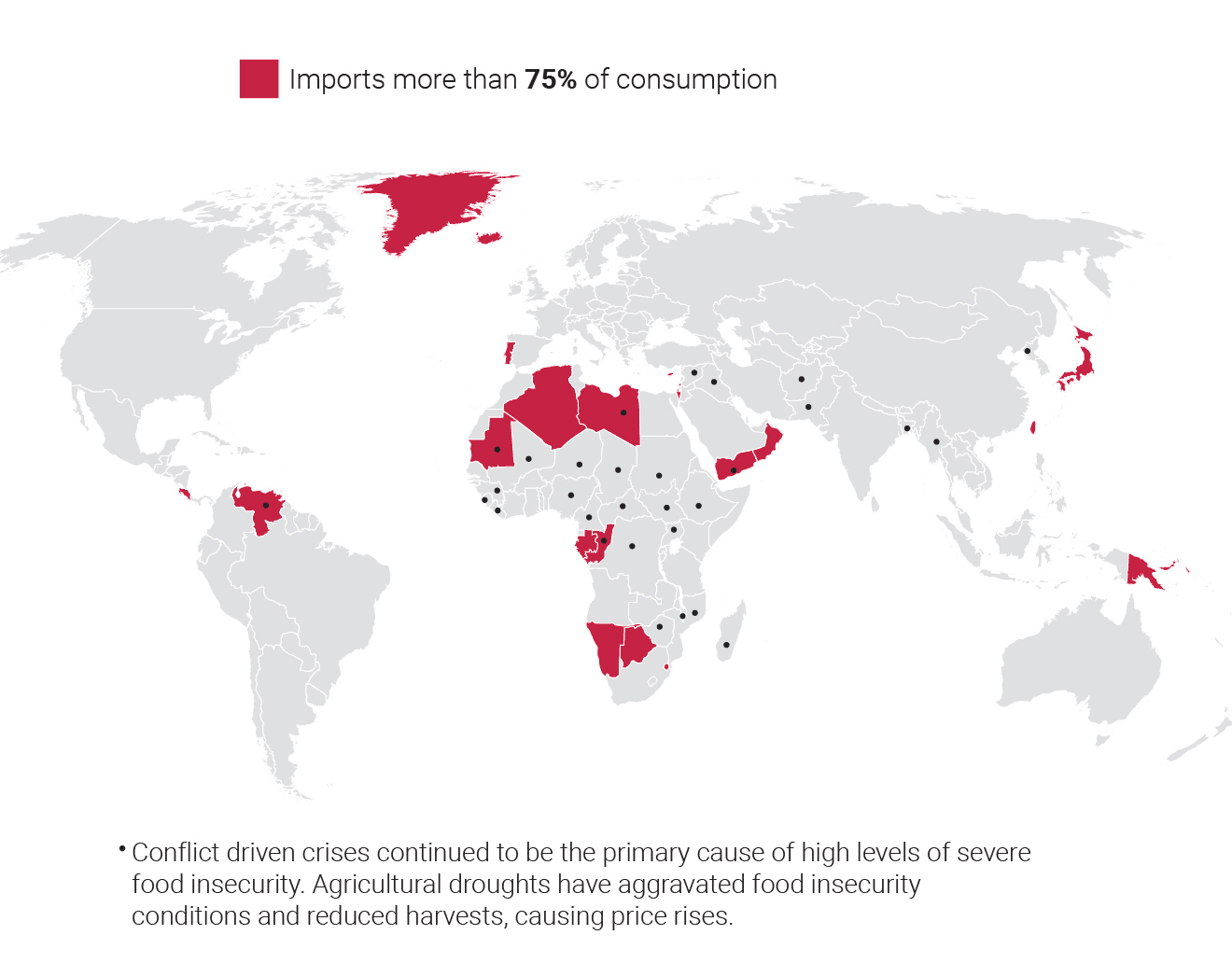
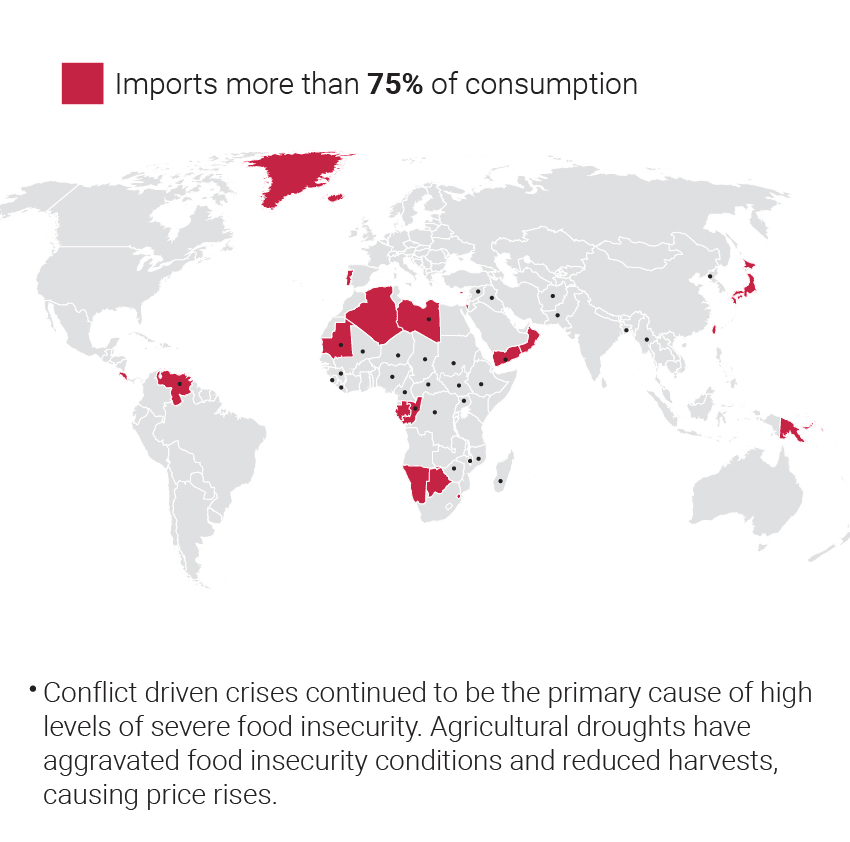
Typically, countries dependent on food imports tend to be small with land reserved for urban planning. Countries such as Djibouti, Tuvalu or Brunei have virtually no space for agriculture. Other countries that depend heavily on food sourced elsewhere include the Middle East, some Asian countries, as well as developing nations in Africa.
Some countries like the United States, China, Germany, Japan, Britain and other developed economies are large importers of food, but this does not mean those countries are food insecure. It is important to understand that many countries importing large amounts of food are also among the richest, and are potentially capable of becoming fully self-sufficient if they so choose. In these cases, the importation of food is due to the desire for a greater diversity of produce to satisfy demanding consumers, not to guard against famine.
Case study: Singapore
Singapore is highly urban, with arable land particularly inaccessible. The island city-state has 724sq km with just one per cent allocated to food production.
In 2017, Singapore imported 90 per cent of its food from 170 countries, one of the highest percentages in the world. Food destined for Singaporean plates comes from neighbouring countries like Malaysia, Thailand and Indonesia, as well as from as far away as Argentina and Uruguay. In recent years, this has led to significant increases in prices and shortages of products like eggs and some types of fish and shrimp, particularly from Malaysia.
VALUE OF AGRICULTURAL IMPORTS (US$ MILLION)
FOOD ORIGIN
The government has set itself a goal of making Singapore 30 per cent self-sufficient by the year 2030, without increasing the amount of agricultural land. This means that the productivity of existing farms will need to be three times greater than they are now.
Top 5 commodities (US$ Million)
DISTRIBUTORS
Food exchange is a strategic sector which governments can manipulate through subsidies, direct incentives or by providing facilities to boost performance, which can add tension to the supply chain. The coronavirus makes distribution much more precarious than usual. For instance, ports face temporary closure any time dock workers who test positive for Covid-19. Distribution efficiency is also challenged because manual workers, including transport workers, cannot work from home. There are threats of strike action amid fears of contagion, and with many workers part of the gig economy, many livelihoods are at stake.
Marine transport and cargo disruption
The shipping industry is at grave risk with anxiety surrounding the health and safety of passengers and crew. It is difficult to release crew members once a ship sets sail and some transport workers are refusing to go to areas affected by the coronavirus. To make matters worse, there are often delays authorising ships to approach ports with the possibility they will not be granted the right to load or unload merchandise.
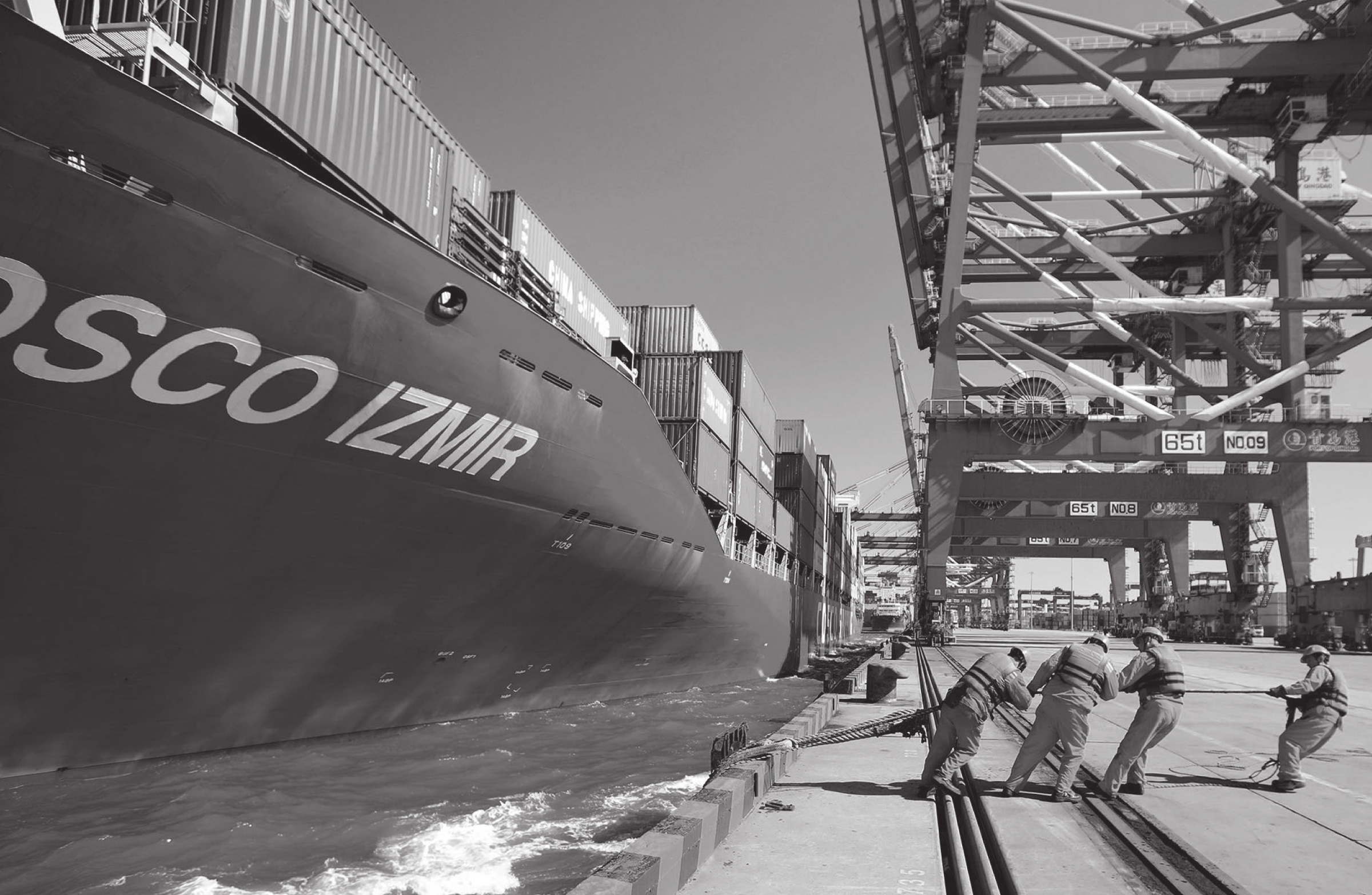

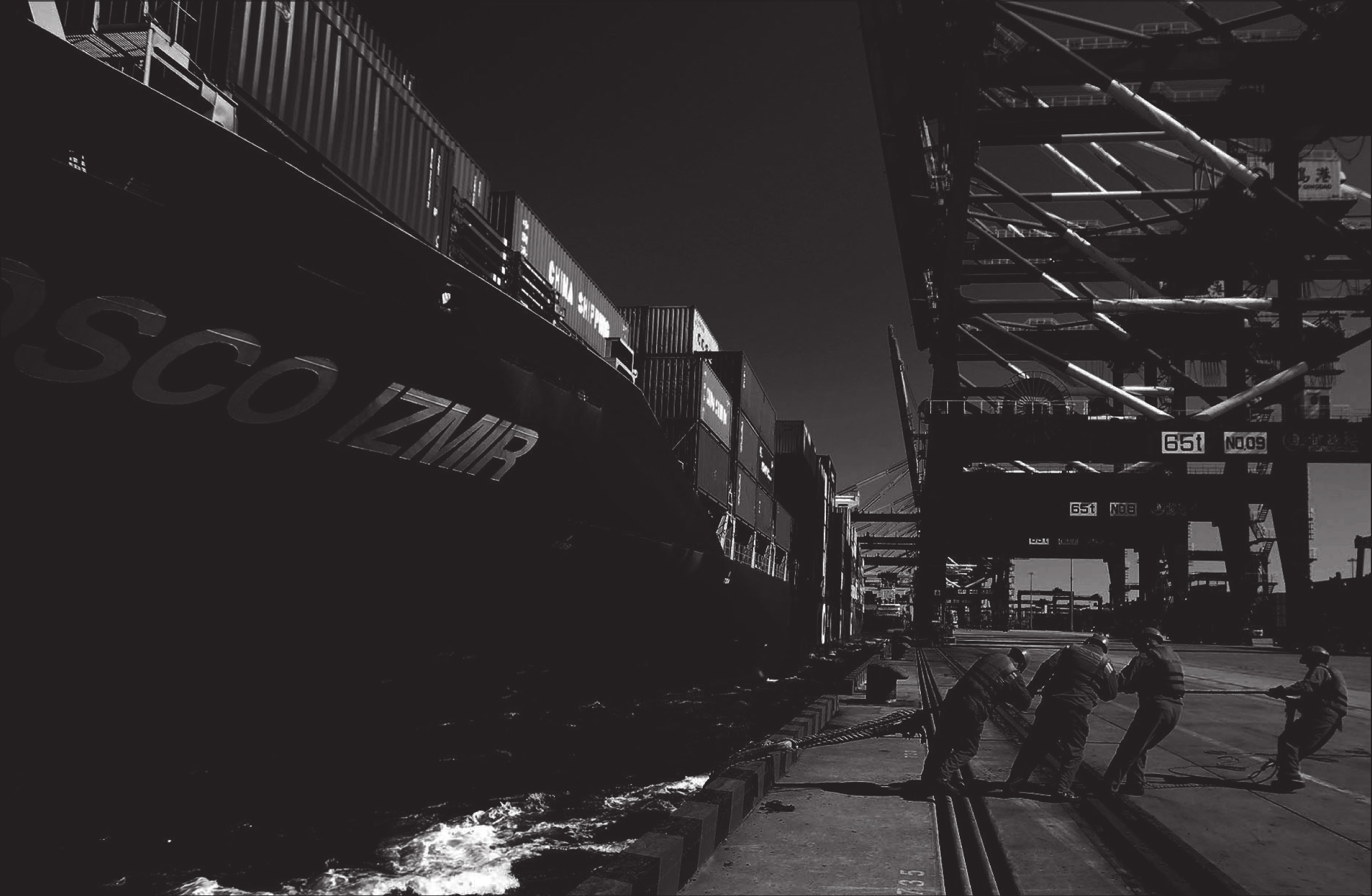
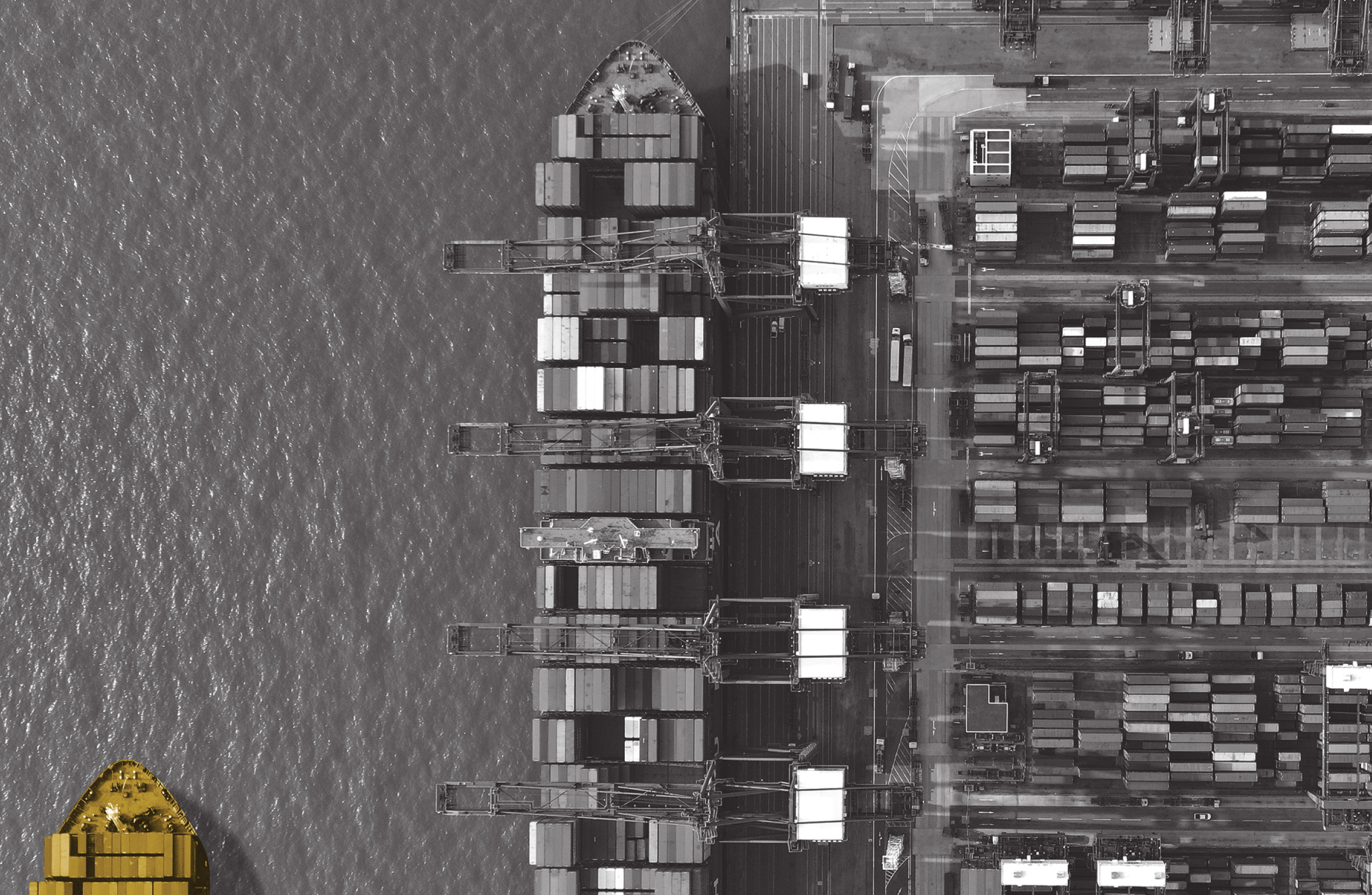
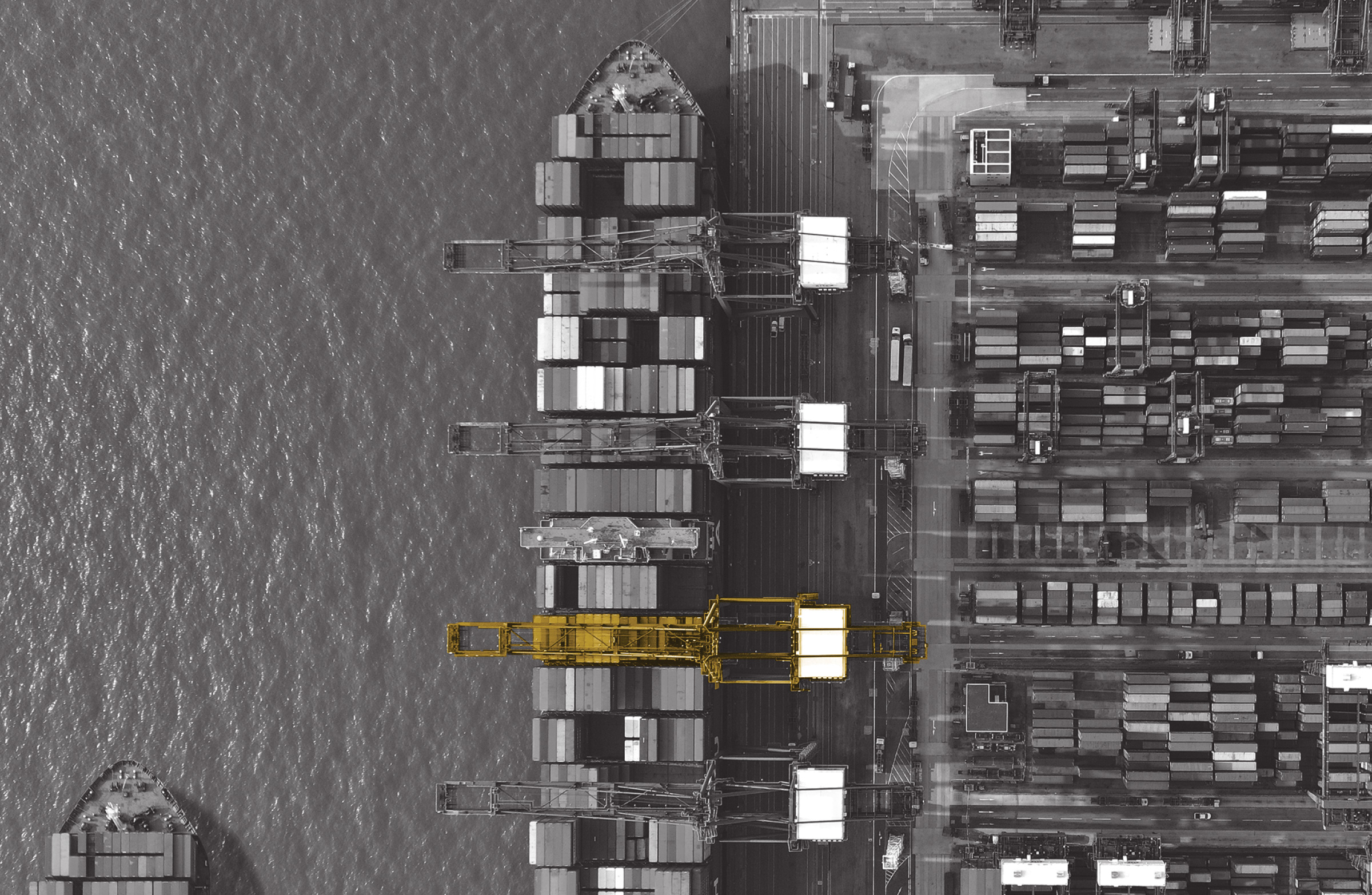
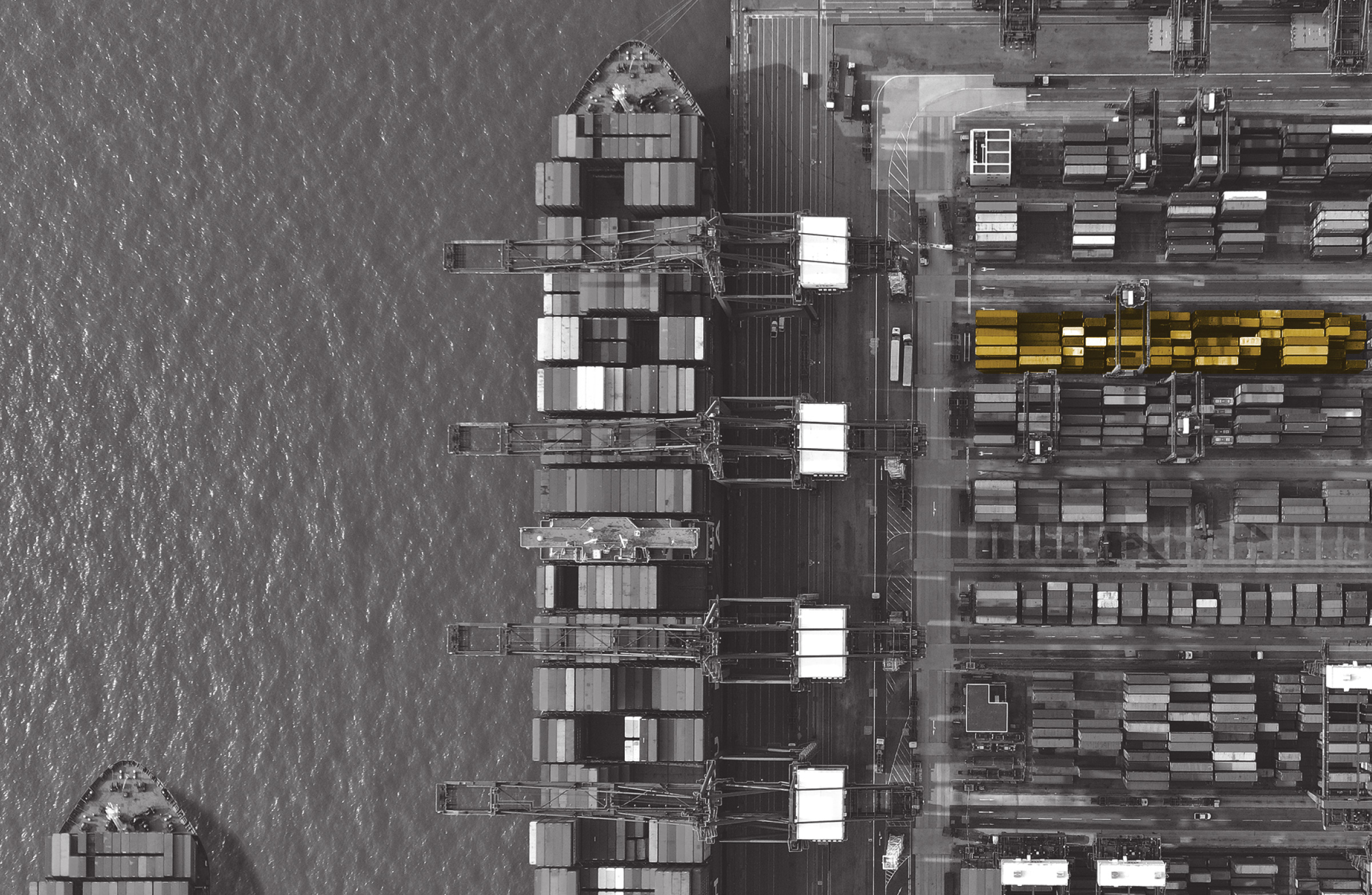
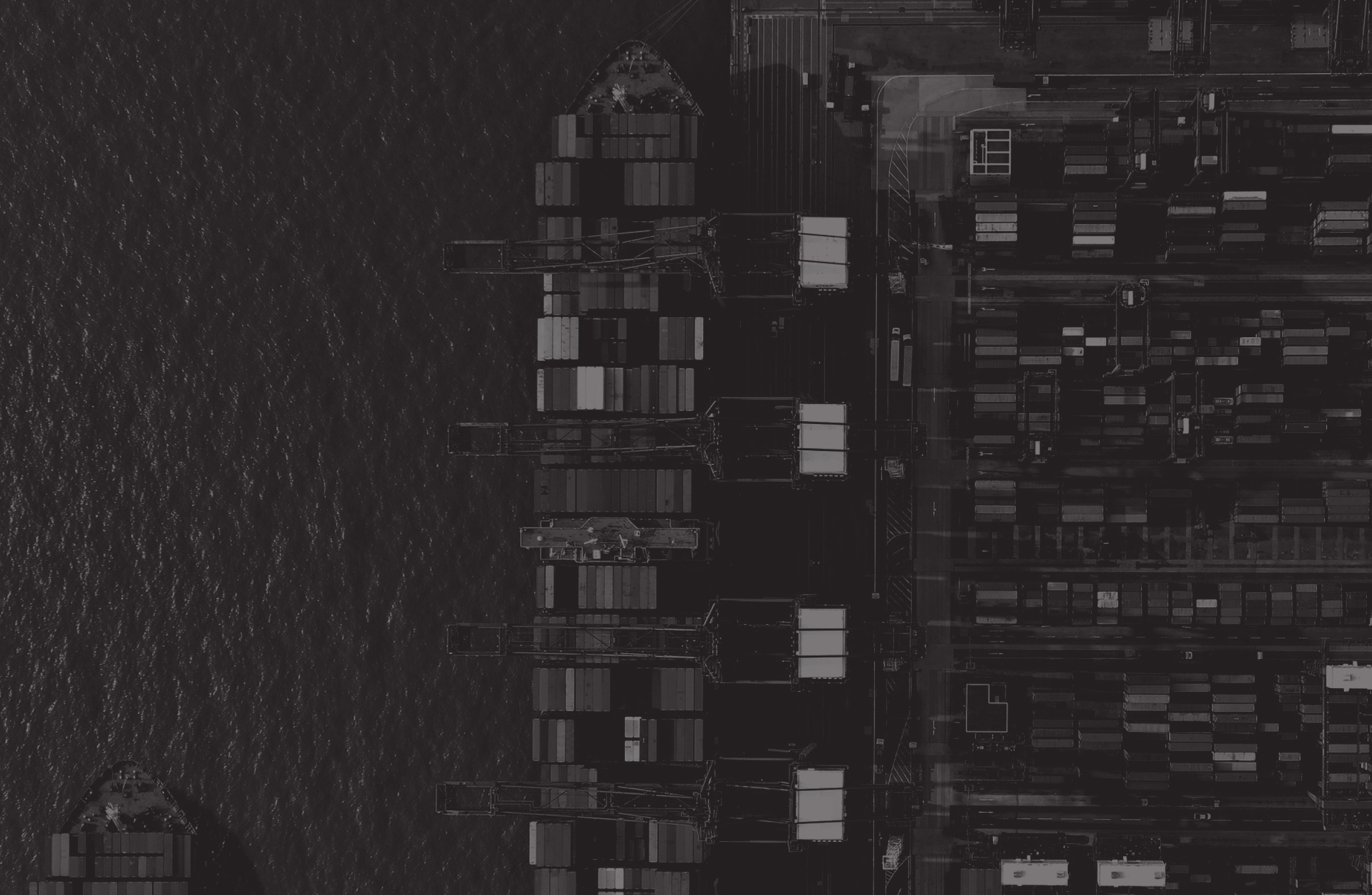








Lack of stevedores
Stevedores work round-the-clock shifts to load and unload cargo to and from ships as safely and quickly as possible. They are an important link in the supply chain that stretches from the consumer to the producer of the cargo.
Main Shipping routes and key points
(Hover over the ports for further details)
Remote pilotage requirements
No crew members will be allowed to disembark
Any shore personnel embarking or attending the vessel will not be allowed to disembark
NUTRITION AND SUPPLIERS’ INCOME
Nearly 87 per cent of the world's student population has been affected by the implementation of the closure of schools and educational centres in more than 160 countries. This measure means the cancellation of school meals, sometimes the only source of nutrition for children in vulnerable situations.
School closures caused by Covid-19
RETAILERS
Countries dependent on food imports are made especially vulnerable from shipping delays because the local currency is at risk of losing value against the US dollar, reducing the country's purchasing power. Sudden increases in food prices occurring from unpredictable markets directly affects retailers and consumers. China saw a pronounced rise in the cost of food from panic buying. In Italy, the demand for flour and canned food shot up after people began to hoard non-perishables instead of buying fresh food.
COUNTRIES WHERE CURRENCIES PLUNGED AGAINST THE DOLLAR
DOMESTIC PRICE WARNING
Countries where prices of one or more basic food commodity are at abnormally high levels in the main markets (identified by the indicator of price anomalies) could negatively impact access to food at national level. Data as of March 11, 2020
CHANGE IN CONSUMER DEMAND
Italy has been one of the countries most affected by the coronavirus outbreak and experienced a noticeable change in the patterns of product consumption. The data is from the period of February 23, 2020 to March 11, 2020, compared to the same period a year earlier.
CONSUMERS
As the pandemic develops, new patterns of consumer behaviour have emerged as consumers’ priorities change.
This is the final link in the supply chain where supply problems can lead to economic and humanitarian crises. These in turn could develop into conflict or famine and affect other areas of society globally.
An investigation by Nielsen Global Connect identified six levels of behaviour as consumers address concerns surrounding the Covid-19 outbreak. The thresholds indicate early signs of spending patterns, particularly for emergency pantry items and health supplies. This type of pattern is seen in various markets.
KEY CONSUMER BEHAVIOUR PATTERNS
American consumer behaviour as Covid-19 concerns rise
US sales growth compared to previous year
Graphic and content editor Darren Long
Additional web development by Dennis Wong
Sources: UN Food and Agriculture Organization of the United Nations, UNESCO, Agri-Food and Veterinary Authority of Singapore, Brinknews, McKinsey & Company, Locust watch, Our world in data, Deutsche Welle, exchangerates.org.uk, United States Department of Agriculture, International Labour Office, European Foundation for the Improvement of Living and Working Conditions, Eurostat, Harvard Web Publishing, The Nielsen Company, The Association of Convenience Stores (UK), International Maritime Organisation, worldatlas.com, Lockton Companies
Photos:Roy Issa(SCMP) and Reuters